Arthur Liebscher, S.J.
Jesuit Alumni Liaison
June 2021
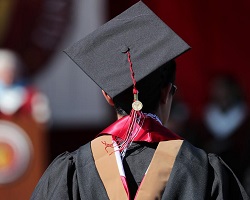
We all join the chorus praising the women’s soccer team and their tremendous victories over North Carolina and then Florida State. Winning the NCAA championship is a gift to us all, and we need a gift. We’re proud of them, and we’re glad for the joy they’ve given the campus. As students poured into the spontaneous party on Bellomy Street—an event that made all the Bay Area TV stations—you could feel renewed energy around campus. Even the Santa Clara Police seemed to enjoy the moment. The excitement and pride both adds a fitting backdrop for graduation.
Undergraduate commencement stands as one of my not-so-secret pleasures. I relish being part of each graduating class’s celebration of its time at Santa Clara. On June 11 we’ll have an in-person graduation—three undergraduate ceremonies, to be exact. They will differ from a stadium ceremony or, for those of us from an earlier era, graduation in the gardens. This year, not everyone can be nearby, and a “virtual” graduation will roll out the next day. Next October’s Grand Reunion will include a live graduation for the class of 2020, and I’ll be there with bells on.
Graduation presents a moment of inflection, a pivot point. Commencement, by definition, looks forward, but in any year the future remains undefined and unknown. Graduating seniors mostly reflect on the past—on the learning, experiences, and, above all, the friendships formed in college. After the past year and half, this 170th commencement will be an especially poignant moment for everyone.
Since the final weeks of Winter 2020, with instruction confined within the now-famous Zoom interface, we have gained a new realization of the value of the Santa Clara academic community. Instructors struggled mightily to reimagine teaching methods built up through their careers, but students learned much in the classes, presentations, and discussion groups conducted over the internet. Still, we haven’t been side-by-side, and we all have a deeper appreciation for the bonds formed by learning together in the classroom, library, labs, and residence halls.
This year, despite being hobbled by the virus, student life and living have managed to build the bridges that will define their memories of this year. Some activities took place online, which offered some contact in the absence of being in the same room together. Our friends in Campus Ministry offered many opportunities for prayer, discussion, and worship, and their efforts reached out to Santa Clarans living in the diaspora of the pandemic.
Again, nothing replaced being together, and real-world contact was never fully defeated. In spring quarter, several hundred students were happily able to move into the residence halls situated east of The Alameda. All through the year, though, the neighborhood south of Market and west of Lafayette was populated and gently abuzz. The students there had yearlong leases, and the property owners didn’t think an epidemic sufficient cause to forgive rental contracts. Most of the time, life was lived within necessary limit, with the pent up energy fueling the post-championship celebration. For these undergraduates, many hundreds strong, the year’s friendship and forced togetherness strengthened their bonds to each other and to the wider Bronco family.
Beyond our relatively tame local stress, global suffering, American politics, and international turmoil have made 2020–2021 a year to both forget and remember. Three weeks ago, the university president’s sudden resignation focused our sense of a world turned upside down. We send Fr. O’Brien our gratitude and support, and we remain confident that our shared generosity and wisdom will let us forge ahead with success and confidence. May this graduation be a true moment to commence our future as members of the Santa Clara community.
Arthur Liebscher, S.J.
Jesuit Alumni Liaison

Photo taken by M.G. Kafkas
This month of April brings seasons and feasts sacred to a large part of humanity—Passover, Easter, and Ramadan. From each faith perspective, each feast describes a yearning to encounter God within our lives today. The three celebrations take place occur within the human experience, and all three observances focus on the mercy of God and the journey into holiness.
The past weekend, the Jewish people concluded the observance of Passover, the eight-day observance that marks the Exodus, the liberation of the Hebrew people from servitude in Egypt. In the Exodus, the Lord engaged the people within their history and their experience. “I will take you as my own people, and I will be your God, and you will know that I, the Lord, am your God who has freed you from the burdens of the Egyptians.” Passover, including the Seder supper, celebrates a journey from slavery into the freedom of the Promised Land.
Christians have just marked Holy Week and Easter, in which they remember and re-enter Passion and Resurrection of Jesus. This is the Christian Passover. As the Chosen People were delivered from servitude, so the Savior is delivered through suffering and death into the Resurrection. This is no moment of spectator sport; Christians themselves join this journey. The Incarnate Lord has taken on human existence, even its suffering and death. Through Christ’s sacrifice, the faithful understand that human beings join the Resurrection and thus enter into the life of God. Christians have spent the last two millennia trying to get their minds and hearts around this idea.
Next week, the people of Islam begin Ramadan, the annual month of fasting and prayer in the quest of closer union with both God and their believing community. In the discipline and sacrifice of fasting, people learn gratitude and appreciation for both their God and their community. At the end of each day’s fasting, they join together in prayer and a much-appreciated meal. Ramadan is a time of reaching beyond the moment and journeying closer to God and fellow Muslims.
I cannot pretend any authority in writing about either Judaism or Islam. I am a Christian, a Catholic priest, and Christianity is complex enough. Still, these three faiths, all derived from Abraham, embrace the God who is present and active in human experience. Passover, Holy Week, and Ramadan draw believers closer to the Lord who is God of both history and eternity.
We live in a tumultuous moment, and, after the past year, we certainly need deliverance. The world’s journey through the pandemic has not ended, but as vaccines become more available, we have hope. Our nation still reels from the storm of political confusion, but the waves are subsiding. Our University knows turmoil and bewilderment even as it continues on the road to building a community of learning, mutual respect, gratitude, and grace.
Perhaps we can join in the invocation given to Moses and Abraham in the Hebrew Book of Numbers. Christians have received it in the common Scripture, and Islam respects it as part of the Torah. Jesus and the disciples would have prayed it at the meal we call the Lord’s Supper on that first Holy Thursday. “The Lord bless you and keep you! The Lord let his face shine upon you and be gracious to you. The Lord look upon you kindly and give you peace.” [Num 6:24–26] This springtime, let us look for blessing and deliverance, for the gracious face of God, in the midst of our very confusing world.
Arthur Liebscher, S.J.
Jesuit Alumni Liaison
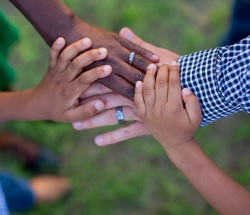
We have it straight from the eagle’s beak or, at least, from the streamers it holds: E pluribus unum—"Out of many, one.” The eagle and the slogan, of course, appear on the Great Seal of the United States adopted by Congress in 1782, seven years before the Constitution itself went into force. It advances the ambitious goal that the disparate colonies and their peoples would come together as one. This year, in his inaugural address, our new president embraced unity as a promise of healing and rebuilding, and he concluded, “I ask every American to join me in this cause.”
In the month and a half since the inauguration, we have rediscovered that “unity” will be a long, hard slog, if, indeed, we know what unity means or whether we even want it. Separation and division course through our country and our human experience. Fear builds barriers, and we are more aware of differences than anything like unity.
Throughout human history unity has proven elusive, whether we talk about government, society, or even (perhaps especially) faith. St. Paul’s letters to the early churches exhort early Christians to be unified; evidently, staying together was a challenge even at the outset. Nonetheless, despite their fractious tendencies, faith traditions offer a way forward based less on unity than on something more local and engaging: community. Unity remains abstract; community starts on our doorstep.
Pope Francis, in his 2020 encyclical letter Fratelli tutti, “Sisters and Brothers All,” asserts that unity and even democracy have been so “bent and shaped to serve…as meaningless tags that can be used to justify any action” (§14). In place of unity, Francis emphasizes community, and he writes, “Unless we recover the shared passion to create a community of belonging and solidarity worthy of our time, our energy and our resources, the global illusion that misled us will collapse and leave many in the grip of anguish and emptiness” (§36). To discover this shared passion and build this community, we need the help from something or Someone who lets us transcend the constrictions and divisions of the present world.
In a recent Wall Street Journal article, correspondent Francis X. Rocca asks, “Can Catholic Social Teaching Unite a Divided America?” (Feb. 5, 2021). Rocca concludes that the long history of Catholic social morality offers fundamental concepts for strengthening national life. In particular, he highlights Pope St. John Paul II's embrace of the dual concepts of solidarity and subsidiarity. In a 1987 encyclical, John Paul defines solidarity as “a firm and persevering determination to commit oneself to the common good; that is to say to the good of all and of each individual, because we are all really responsible for all” (Sollicitudo rei socialis, “The Social Concern of the Church,” §38). Following Catholic tradition, he argues that solidarity must respect subsidiarity, that is, honor the needs, rights, and freedom of local communities as they search for justice (Catechism of the Catholic Church, 1992, §1883; Ecclesia in America, “The Church in the Americas,” 1999, §55 and 71). We may be one, but we have differing, entirely worthy ways of living with the common good. We can and must hold onto the complementary goals of solidarity and subsidiarity, unity and diversity, as we forge a life together.
Building community requires that we as a people set out a spiritual and political journey, and Lent is a good time to start. In this season, we examine ourselves and our need for God. We ask for the gift to envision a community structured by law and inspired by mutual respect and trust. Let us pray that God helps us to turn our vision ever outward so that we might overcome fear and resentment, so that we can honestly proclaim, “Out of many, community.”
Arthur Liebscher, S.J.
Jesuit Alumni Liaison
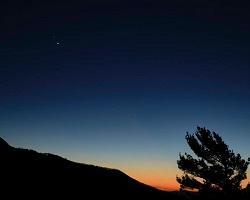
Photo courtesy of NASA/ Bill Ingalls
Just before Christmas, shining in the southwestern sky, Jupiter and Saturn appeared almost as one in our line of sight. The event marked their closest observable “great conjunction” since the year 1226. In the intervening centuries, empires, kingdoms, and countries appeared and disappeared. Eastern and Western hemispheres met, and a new world was born. This year, the two planets again reach out to us, seemingly across time, space, and history.
The Internet dubbed the present event “the Christmas star” and speculated whether the same phenomenon had drawn the Magi, three Wise Men from the east, who sought out “the newborn king of the Jews” (Matthew 2:1–12). This week in January 2021, the feast of the Epiphany recalls the story of the Magi. Astronomers and theologians alike dismiss the notion that a planetary conjunction summoned the travelers to ancient Judea. Still, the celestial spheres speak to us and invite us to understand the Magi and their star within the story of our own lives.
Did eastern sages actually bring gifts to the baby Jesus? After all, it is easy to dismiss the passage as a pleasant legend lacking factual support. Here, though, we should recall that we encounter facts only within a context that gives them meaning. We have so many sources of fact that we easily lose track of their significance. We literally lose the plot that explains our lives. In contrast, ancient peoples passed oral stories from region to region and generation to generation. We might ask what really happened, but, in the ancient world, people found reality in a story’s eternal meaning.
The Gospels constitute an inspired literature that communicates the people’s experience of the Divine. While telling us of the faith of the early community, Scripture engages our own faith, that is, our encounter with the Spirit of God. As 2021 begins, we can join the early Christians in seeking meaning in the story of the Magi.
The Nativity invites us to consider events focused on outsiders. A King may have been born, but the Holy Family traveled as strangers displaced by events to the little town of Bethlehem. Luke’s Gospel (2:8–20) tells us that angels first proclaimed Christ’s birth, not to important people but instead to humble shepherds. Matthew’s Magi likely came from Persia, modern Iran, and embraced the ancient Zoroastrian faith. Foreigners in both origin and belief, they were yet called to honor the infant King. Their story resonates in our modern world divided by wealth, driven by suspicion, and scarred by conflict.
The third-century theologian Origen wrote that the gifts of the Magi describe Jesus—“gold, as to a king; myrrh, as to one who was mortal; and incense, as to a God” (Contra Celsum, Chap. LX). We can recognize that we, too, can offer gifts, not just material things but the very value of our humanity. We respond to God’s presence with all the strengths, abilities, and even limitations that define our lives.
The Wise Men traveled far because they sensed a momentous event in world history. Through the weeks of Advent, Christian worship expresses a yearning for the Lord’s Nativity, for the new era established in his life, death, and resurrection. Two thousand years later, such longing for a world-changing event resonates beyond the Christian community. We face threats to the health of our citizens, society, and planet. Whatever solutions we envision, we all want to rise to the historical moment by restoring and reimagining our world.
The journey of the Magi is our journey, and their star still calls us forward.
Photo courtesy of NASA's "The ‘Great’ Conjunction of Jupiter and Saturn"
Arthur Liebscher, S.J.
Jesuit Alumni Liaison
Early December brings shorter days, chillier weather, and the church season of Advent celebrated on Christian church calendars. Advent has its symbols—the wreath at home and in church, purple colors, the somber spirit of a mini-Lent, a season of penance. It is a time of yearning but also a time of patience. We wait in the hope that Christmas will bring an answer to our longings.
More and more, I find myself telling stories about times “when I was a boy.” At our parish school in Sacramento, we frequently heard the refrain, “Keep Christ in Christmas.” The slogan, now furthered by the Knights of Columbus, focuses our sensibilities away from so much of popular Yuletide culture, especially shopping and gifts. Needless to say, we kids weren’t so enthused about limited hopes for Christmas presents.
In recent years, our end-of-the-year arguments have often surrounded the question, “Can we even wish someone ‘Merry Christmas’”? Shopping malls and greetings are accused of succumbing to the anti-traditional and perhaps anti-American allure of “Happy Holidays.” As a people, we yearn for simpler times and familiar imagery. Does any of this reflect what we really desire?
We enshrine our hopes for Christmas symbols that remind us of things American—a jolly Santa Claus, hours of traditional music, time-honored winter scenes, glittering shopping expeditions, and reruns of “It’s a Wonderful Life” with Jimmy Stewart. The images of snow and sleighs have never quite fit life in California, to say nothing of ancient Palestine, but we have learned to respond to the sentiments. Do they really represent the longing of our hearts?
When, at age 25, I spent a Christmas in Santa Fe, Argentina, the North American in me was surprised that snow, evergreen trees, and jingle bells found no resonance in the Southern Hemisphere, where December means the middle of summer. On Christmas day, the thermometer hit a humid 40° C (104° F), and we barbecued beef on the patio. On Christmas Eve, la nochebuena, people showed up for Mass, but they did the same on most Sundays, cold or hot. A Santa-like Papá Noel might show up in print, a little overdressed for the climate, but gifts were modest, appeared on the feast of Reyes (Epiphany), and directed toward the children.
Thinking about customs brings us back to Christian Advent. What do “penitential season” and “penance” even mean? Here, penance suggests, not punishment, but instead putting something aside, “clearing the way,” to reach what we want and need. The issue for Advent and Christmas, then, is to ponder what our hearts truly desire.
This year, with our celebrations frequently battened down, we may finally have a chance to attend these earnings of our heart. Of course, we want to get through to the other side of this pandemic. We look forward to spending unworried time with family and friends. We want to be return to churches and other public places. We long to travel again. These things are pretty basic, and the basics, just maybe, may beckon more brightly in our lives.
At Christmas, we look for “peace on earth.” What could be more fundamental yet apparently unreachable? We live in an era in which social and political rancor marks national life, not just the United States, but in many parts of the world. We ought to recall that peace does not require complete agreement, which will always be beyond our ability. Neither does an election magically produce accord. Still, following an election, we agree to respect the outcome, whether or not we much like it. This year, respect for both the process and our fellow citizens is in short supply.
May this Advent season help us “clear the way” to a world of fundamental decency among all people, whatever their origin, opinions, race, or faith. Without such human respect, we have no hope of promoting peace on earth. With our education and experience at Santa Clara, we stand ready to do our part. Kindness for all—the Prince of Peace will find this a worthy Christmas goal.
Arthur Liebscher, S.J.
Jesuit Alumni Liaison

Today, the day when the November Bronco Connect appears, is Election Day. We have witnessed a campaign like none other in our lifetimes. While we hope for resolution and even reconciliation, health, civil liberties, racism, and social disparity will certainly continue to drive wedges into our life as a nation.
How will the Santa Clara family address this juncture of human and national history? With the Franciscans who founded the Mission, we might take as our calling the words inspired by St. Francis of Assisi: “Lord, make us instruments of your peace.” In this world, how does our extended Santa Clara family bring people together as we educate our students and then find our way forward as alumni?
Another Francis, the pope, has recently given us a message that somehow finds hope in this moment of discord and fear. On the October feast his namesake and patron, the pope issued a document that addresses the calamities and challenges of this year and this era. This document is Fratelli tutti, Sisters and Brothers All, a title inspired by the thirteenth-century “Admonitions” of St. Francis. With this starting point, the letter looks toward “a love that transcends the barriers of geography and distance….[an] openness that allows us to acknowledge, appreciate and love each person, regardless of physical proximity, regardless of where he or she was born or lives (par. 1).”
Describing our world, this century’s Francis sketches the resurgence of social evils—loss of human dignity, polarized government, “destructive fanaticism” (par. 46), and denial of human dignity within and among nations. Still, as teacher and guide, the pope wants to give us a sense of meaning that shapes our response to the present crises. He urges us to find purpose in our common humanity and ability to reach over barriers to promote the good of everyone.
Pope Francis takes the parable of the Good Samaritan as his central image. In this story from Luke's Gospel, Jesus is asked, “Who is my neighbor?” He replies by describing a man beaten and stripped by roadway robbers. Two figures representing the religious establishment, a priest and a temple warden, saw the victim, felt pity, but did nothing. Someone very different, a traveling Samaritan brought the victim to an inn, attended to him, and paid for his continued care. The Samaritan represented a competing Jewish sect despised in Judea. Moved by a sense of mercy, the outcast Samaritan transcended the walls of rivalry, tribalism, and propriety. The Samaritan became the injured man’s true neighbor. The pope concludes, “[The Lord] asks us not to decide who is close enough to be our neighbor, but rather that we ourselves become neighbors to all” (par. 80).
We Americans will wonder whether Pope Francis’s concern about hostility and division addresses us in particular. Similarly, when he asserts that “the right of some to free enterprise or market freedom cannot supersede the rights of peoples and the dignity of the poor” (par. 122), we will likely ask whether he takes direct aim at the American economic system.
No, Pope Francis is not writing to us, at least, not to us uniquely. The pope speaks from a universal pulpit, and his view is not limited to any single political or economic system. Instead, he looks to a vision of “fraternity and social friendship” rooted in the sister- and brotherhood given us by our Creator (par. 1–8). Francis asks us to transcend walls created by aggression and fear, and, in Fratelli tutti, he explores how we can set about renewing our imagination to create a better world for everyone. Pope Francis sees humanity at a critical point. We can go forward or fall backward—climb over barriers or cower behind them.
Fratelli tutti, Sisters and Brothers All, is long but worth the trouble to read with thought and consideration. Pope Francis nudges us along to overcome fear and build the common good. We have a fine university, and our students graduate highly competent in the ways of human learning, enterprise, and technology. Still, we have something more, a “secret sauce” special to Santa Clara. Beyond a knowledge of “what is,” we impart wisdom about "what might be."
Whatever comes to us in the months and years ahead, Santa Clara will help humanity transcend its limits and accept its vocation to build a just world for all peoples.
Arthur Liebscher, S.J.
Jesuit Alumni Liaison
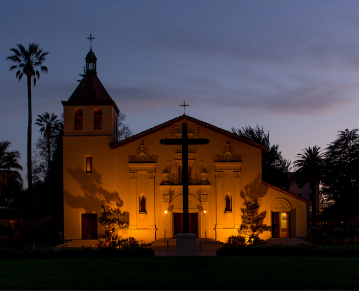
I vividly recall my graduation from Santa Clara, even after these many years, and I have enjoyed being a faculty participant at dozens of commencements in the intervening decades. When we bring together each year’s class, togged out in academic colors and sitting with their friends, we reaffirm Santa Clara’s life. Every year, our graduates celebrate their accomplishments, and the traditional pomp reaffirms the momentous sense of the occasion. This year, the graduates enter a world that needs them and their education more than ever before.
The spirit of Santa Clara lives, one way or another, in everyone who graduates. In some fashion, we all carry SCU in our hearts and minds as we negotiate the paths of life. We learn some things in class—knowledge, skills, an ethical horizon, critical ability, and, yes, an awareness of the transcendent. Beyond the classroom, on the campus, we build key relationships founded on mutual respect and belonging. Our graduates remain part of a university community whose influence, often quietly, shapes their future choices.
Commencement 2020 was no different—except, of course, it was very different.
On June 13 graduates and their families watched an online ceremony from around the country and the world. They had a surprise speaker, California governor and fellow alum Gavin Newsom ’89. They heard commendations from an array of Santa Clarans distinguished in government, sports, education, public service, and business. Pandemic-appropriate celebrations marked the moment, both here and elsewhere. I spoke with graduates later, and they expressed enthusiasm, gratitude, and pride.
At Santa Clara these graduates learned confidence in their own abilities, and they came to understand humanity as a world community to which they can and will contribute. Their education has helped them understand other peoples and ways of life, and they have realized that learning is, in fact, a global endeavor joining peoples from our part of North America to Europe, Asia, Africa, and Latin America. With their growing acquaintance with world cultures, they have come to comprehend the broken state of human existence. Racism, vast inequality, systemic violence, and denied opportunity all testify to the reality that original sin has power in our world.
Inevitably, the Mission Church itself, very much the symbol of our campus, reminds us our fractured but still hopeful nature of our existence. Self-sacrifice and zeal for the native peoples marked the lives of the original missionaries. Still, as is often said, “cross and sword” traveled together. The missions established European civilization in Alta California, and Spanish troops imposed control, often through force and intimidation.
When Santa Clara College was founded in 1851, California had recently passed to the United States in the wake of the Mexican-American War. In his 1979 book The University of Santa Clara: A History, 1851–1977, the late Fr. Gerald McKevitt described the multiethnic student body of the young college—Mexican and californio residents and usually Catholic settlers from North America and Europe [pp. 39–43]. The tide of expansionism spurred by the Gold Rush and California’s statehood soon overwhelmed their mid-century world. The new, American California offered great opportunity, but the new arrivals suppressed the native peoples, pushed aside the Spanish-speakers, and exploited arriving Chinese workers. Standing as a witness to these waves of change, the Mission Church reminds us that oppression and violence have many faces.
The Mission, of course, is a place of worship that celebrates the Crucified Jesus, through whom many of us have placed our faith in God. We’re sometimes tempted to think that the history of sin and oppression means that God is, at best, irrelevant. That’s an error. Human failure shows our need for salvation and rescue. Christ himself experienced the effects humanity’s sinfulness, and his teaching reminds us that the lives of people on the margins matter to God. The lives of the first people matter. Undocumented lives matter. And, especially at this time in our nation's history, Black Lives Matter.
If those who are vulnerable don’t matter, none of us matter. We’re all part of one society, one nation, one campus. Santa Clara’s influence in California and the nation depends on our striving for breadth and reconciliation both on our campus and beyond. In late June called us to "look critically at the work we do. We must ask difficult questions. And we must create firm, actionable responses….”
For me, a well-intentioned but aging white man—albeit a long-time student of the Latin American world—it’s easy to embrace a vague commitment to social betterment. However genuine our intentions, we struggle to find a way toward conversation, imagination, and great-heartedness. Even though the path remains uncertain, our Santa Clara heritage demands that we pledge ourselves to building a just and unified community. Our students and our new alumni deserve as much.
[I’m grateful to History Prof. Emeritus Robert Senkewicz for his helpful comments as I prepared these thoughts. AFLsj]
Arthur Liebscher, S.J.
Jesuit Alumni Liaison

With Memorial Day just behind us and with a good measure of quarantine-inspired introspection, I find myself still contemplating the generation that survived depression and World War II. I have a photo of my dad taken on Bougainville, now Papua New Guinea, in 1944. Two years earlier, following Pearl Harbor, he had resigned an exempt engineering job and became a Navy Sea Bee officer. In the photo, dressed in field khakis, he holds the handset of a crank telephone precariously mounted on a wooden tent support. My mom served as a nurse on Mare Island Naval Shipyard in Vallejo. Like everyone, they were part of the war effort.
In March, this section of Bronco Connect offered comments on finding faith in the world and then, in April, faith in the midst of crisis. Last month, it started with the Greatest Generation as an inspiration for hope in times of struggle. Now, in June, tradition pushes to the third essential virtue, which is charity or simply “love.” The generation of depression and world war might not have called itself “charitable,” much less “loving,” but its sacrifice and dedication helped build national community and became the bedrock shaping the second half of the twentieth century.
Our Santa Clara campus is living through another historic moment. Normally, we would be winding down the year, cementing friendships, locking in future employment, and getting ready for graduation. Student organizations would celebrate achievements and enjoy the final weeks together. Sunbathers would decorate the lawns, and yard-games would dot the student neighborhood. Not this year.
The pandemic has diminished the rituals and celebrations that shape memories and stir collective affection. Still, in the midst of disruption and uncertainty, the Mission Campus remains part of our lives. It tugs at hearts, sometimes strongly, sometimes tenuously, but always present in our life stories.
The things that bind us together, college and beyond, point us toward this virtue called charity. We often think of “charity” as something we do, such as giving to the needy or helping with a non-profit. These things are essential, but they result from charity, which, in Christianity, is rooted in the love coming from God. It is the life of God flowing through us and binding us to others. However we understand such things spiritually or philosophically, we all know some sense of unity with other humans. Our good desires to sustain and build-up come out of awareness of a shared existence among all people.
At Santa Clara, we often speak of educating young people to serve others. Charity, love, and purpose emerge from who we are more than what we do. We fail our mission if we try to lay service and ethical behavior onto young shoulders already burdened by expectations and demands. Instead, our sense of service has roots in human unity. In charity and God’s love, we are all one. Santa Clara strives to open students to this reality.
On June 13 our graduates will appear in a virtual forum for a commencement event. In another year, I’d be getting a haircut and airing out my academic regalia. Neither is happening, although we hope to celebrate this class again in the year ahead. This month, I’ll ponder how much these young people have become part of my life and hope they stay in each other’s lives. They are Santa Clara alumni; they live in our hearts, and, I hope, we live in theirs. Borrowing from St. Paul (I Cor 13:13), together we find “faith, hope, and love, these three, but the greatest of these is love.”
Arthur Liebscher, S.J.
Jesuit Alumni Liaison
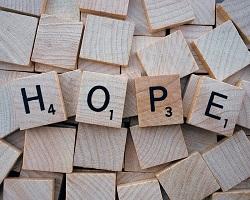
Born in the baby boom after World War II, I was raised by parents from the "Greatest Generation," people born in the first quarter of the last century. They survived both the Great Depression and then they went to war, and the turmoil and danger of both may have made them more open to faith lived within in family and community—often imperfectly, but always with an accompanying hope that their dedication would bring about a better world.
As we enter another month of pandemic and quarantine, we who have succeeded the Greatest Generation—all the way through Millennials and Gen Z—wonder about the future. What lies ahead for ourselves, our families, and our communities? For many, the epidemic's personal and financial damage will require years to unravel. In this time, as I noted last month, we might find the faith needed to commit ourselves to the task ahead. Faith is a "theological virtue," a gift from God, and living it out requires the second great virtue, then one shown by the Greatest Generation: enduring hope.
In our world of politics, power, and tech, if or when we believe, we often hold onto a private faith, with a hope focused on our own improvement, satisfaction, and, maybe, personal salvation. Nonetheless, as believers, we always belong to a community, and our faith needs communal vision. A community grasp of faith does not mean entering the culture wars about private morality, lifestyles, and private freedoms. Those are distinct questions tied more to individuality than community. Instead, community-focused faith looks for a vision that inspires, sustains, and shapes our decisions as individuals and as a people.
The virtue of hope, exactly like faith, comes to us as a gift, and we live it as individuals within a local, church, and worldwide community. Hope does not mean a perpetual cheeriness worthy of Pollyanna. For us, hope lies in realizing that we have the wherewithal to build a future for ourselves, our communities, and our world. Acknowledging good times and bad, joy and suffering, hope directs our yearning to that which we genuinely need.
Our Santa Clara education gave us each some unique expertise useful in this moment. We also learned to understand ourselves as people whose activity affects communities and our planet. Public health, education, and sustainable livelihoods all demand our attention. Our future is at stake, and we know that we can contribute to its creation. Our lives, individually and together, have meaning for the world.
As we face and then overcome this crisis, Santa Clara needs its alumni. That comment is not intended as an oblique way of asking for donations, although, certainly, our students need special help in these days. In a broader sense, we can support SCU education by encouraging young people to choose a Santa Clara education in the coming years. We may be able to offer mentoring to students and young graduates as they face a very changed reality. We can recognize that some fellow alumni will benefit from a community that helps them rebuild. Santa Clara will remain vital if we make it vital.
God will give us hope, but practical hoping will spring up from each of us embracing our talents, our generosity, and our willingness to embrace the vast task that lies ahead.
Arthur Liebscher, S.J.
Jesuit Alumni Liaison
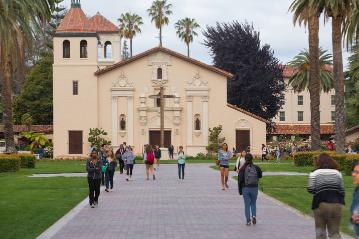
A few weeks ago, I offered Bronco Connect some hopeful thoughts about “finding God in all things,” which is an idea central to the Spiritual Exercises of St. Ignatius. In the intervening weeks, the tragedy of the coronavirus cannot help but leave us wondering, “Where are you, Lord?”
As I write this, the Santa Clara campus sits beautiful but lonely. For spring quarter, Santa Clara students are studying remotely as they adjust their living arrangements, struggle with bandwidth, and wonder what the future holds. Surrounding shops and churches remain silent. Inevitably, the homeless lurk just beyond our sight.
Where could God possibly be? Who could this God be? If we “find God,” it will be the God is who truly is, not the one we fear or desire. We might think God is punishing humanity, likely for the sins of people we dislike. On the other hand, we might think of God as merely a benign figure, one expected to answer our requests, who becomes irrelevant in times of crisis.
The real God neither punishes us nor dotes over us. The real God gives us life and walks with us in all of our experiences. “Finding God” means we are open to move, always forward, on a journey—challenged but learning, taking responsibility as partners in the divine project of creation and salvation. The real God treats us as grown-ups.
On March 27, Pope Francis directed comments and a blessing urbi et orbi, “to the city and the globe.” The pope recalled, from Mark’s Gospel, the story of the disciples who looked for Jesus’ protection in a storm [Mark 4:35–41]. Using the image of the passage, the pope did not shy from the terror of the moment: “Thick darkness has gathered over our squares, our streets and our cities; it has taken over our lives...We find ourselves afraid and lost...We were caught off guard by an unexpected, turbulent storm.”
The pope continued, “We have realized that we are on the same boat, all of us fragile and disoriented, but at the same time important and needed, all of us called to row together, each of us in need of comforting the other...We have realized that we cannot go on thinking of ourselves, but only together can we do this.” We are in the same boat, struggling.
Where, then, do we discover God? Francis prayed, “You are calling on us to seize this time of trial as a time of choosing. It is not the time of your judgment but of our judgment—a time to choose what matters and what passes away...” We find God in the judgments and choices we make.
Our communities suffer not only from the illness, terrible as it is, but also from economic disaster. For the future of the world, we have to sacrifice—staying inside, canceling events, and missing opportunities and future memories. We have to care for ourselves and those we love, and as time goes on, we must consider how we care for and consider the values of a society that isn’t prepared to help the lonely, the powerless, the outcasts, and all those most in need.
We discover God in the real world, not the world of our dreams. Our usual community support—entertainment, school, socializing, and maybe church—have vanished, probably for months to come. Still, we can pray, together with our families and friends. Prayer is never solitary; it joins us to God and to everyone who prays.
In the midst of this crisis, we have the opportunity to find reasons to value and be grateful for life. Anyone who has lived has something to regret but so much more to celebrate. If we are openhearted, this event will let us grow in gratitude for our lives and those of all the people who share our journey.
Inevitably, we will lose some part of the life we knew, and loss will bring on mourning. Grief is inevitable, but it can also yield a new engagement with the reality of our lives, our humanity, and our God. Pope Francis tells us that this is a time to choose “what is necessary from what is not.” In this moment of trial, we can examine our times and commit ourselves to the future as it unfolds. With God’s help, this time of our human judgment will move the human family forward. In that choice and recommitment, we shall glimpse God.
Arthur Liebscher, S.J.
Jesuit Alumni Liaison

How can we start defining “Jesuit education”? We often talk about “Jesuit values” or “Jesuit philosophy,” and, often enough, we boil that down to phrases like “persons for others,” “women and men of service,” and “social justice.” These worthy ideals entirely fit the spirit of the founder, St. Ignatius Loyola, and they provide help in navigating the multifaceted world of higher education Still, Ignatius never exactly said any of those things, which reflect life in the 20th. and 21st. centuries more than the saint’s 16th-century world.
One of our workaday phrases stands close to what we do at Santa Clara and also to the writings of Ignatius: “Finding God in all things.” The thought finds its roots in one of the foundational meditations of the Spiritual Exercises, the Contemplación para alcanzar amor, that is, the “Contemplation for arriving at love.” In it, he writes:
. . . God dwells in creatures: in the elements giving them existence, in the plants giving them life, in the animals conferring upon them sensation, in humanity, giving us understanding. So God dwells in me and gives me being, life, sensation, intelligence; and He makes a temple of me. . . . (Louis Puhl, S.J., trans., The Spiritual Exercises of St. Ignatius Loyola, 1951, § 235)
. . . God works . . . for me in all creation . . . [and] conducts Himself as [an artisan,] one who labors. Thus, in [all things, God] gives being, conserves them, confers life and [gives them] sensation. (§236)
The Spiritual Exercises are just that: exercises for the spiritual life. They present a series of meditations that build a context for both prayer and activity. Like physical exercise, spiritual exercise brings refreshment and strength while opening new possibilities of experience. The Exercises echo the spiritual life and theology of the High Middle Ages and Renaissance. Ignatius’s genius lay in gathering and shaping the ideas and meditations in a way that fuse contemplative awareness of God with a life in the world. Here we encounter another Ignatian byword: “contemplation in action.”
The idea that God sustains all existence suffuses the Spiritual Exercises as it does, of course, all Christian belief. The Exercises are further rooted in the Catholic assertion that Christ’s salvation pours holiness not only into individual believers but also into the community of the faithful and, through us, into the material universe. Creation is essentially holy, not essentially corrupt, and from this, we derive a sense of sacrament—that in Jesus, God is present in our lives and in our world. Such “theological optimism,” the awareness of omnipresent grace, lies at root of Ignatius’s worldview. Admittedly, fear, cynicism, and division all thrive, and the thing we call sin debases and degrades the sanctity of existence. Still, within all creation glows the light of holiness.
For this reason, we at Santa Clara pursue learning as an essential part of spirituality. Everything we do on campus—teaching, research, student activities, support services of many kinds—all this is not only worthwhile; it is also sacred. We engage the world because it is holy, and we hope that our students, both undergraduate and graduate, acquire an attitude of reverence as they contemplate the sanctity of being.
In those same paragraphs Ignatius continues:
. . . my limited power comes from the supreme and infinite power above, and so, too, justice, goodness, and mercy descend from above as the rays of light descend from the sun and as the waters flow from their fountains. Thus, I will reflect upon myself. . . . (§237)
Wherever our origins, whatever our situation, our very existence merits respect. The idea may be more attractive than it is attainable. The contemporary situation challenges us to find ways to responsibly and respectfully address human relationship, governmental policy, the distribution of wealth, and the protection of our common resources.
At Santa Clara we hope that we can guide our students to find meaning, significance, and purpose all around them. We each bring unique background, life experience, and understanding of our place in the universe. We stand with Ignatius in affirming that God’s goodness touches all of us. Let us, in our lives, reflect on ourselves, on the blessings we know, and on our work for young people and the world they enter.
